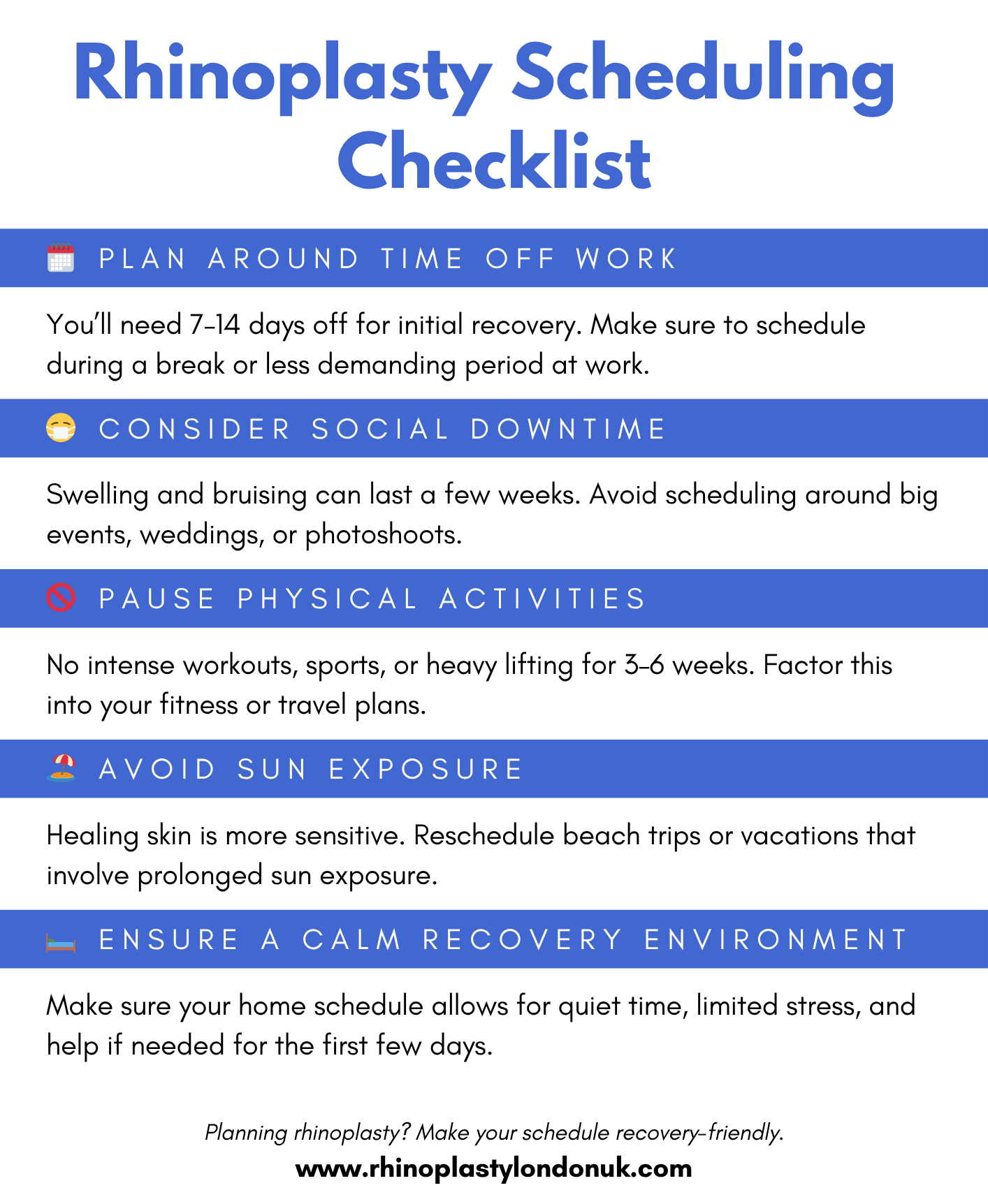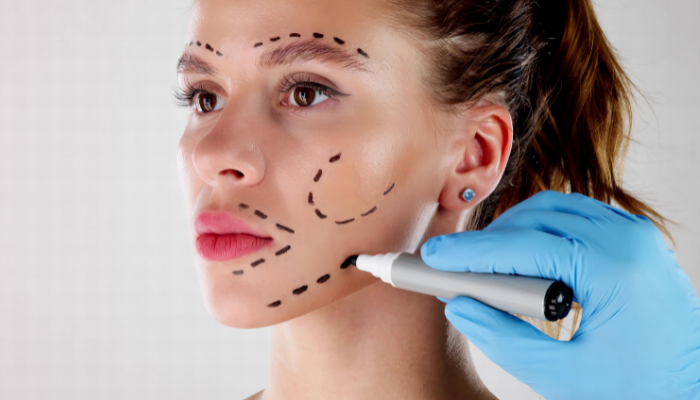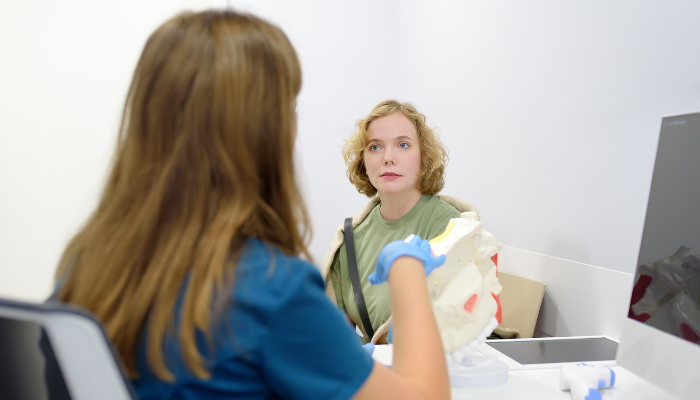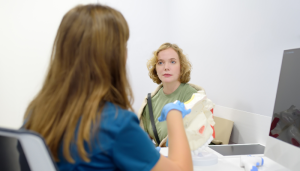Having a nose job is a big decision, and picking the right time for your surgery can make a real difference to how everything goes. This isn’t just about finding a gap in your diary; it’s about thinking about your recovery, the weather, and even your bank balance.
We’re going to talk about the best time to schedule Rhinoplasty Surgery, so you can make a good choice for yourself.
Key Takeaways
- Plan your surgery for cooler months if you can, as it helps with swelling.
- Make sure you have enough time off work or other commitments for recovery.
- Don’t forget to budget for all the costs, not just the surgery itself.
- Choose a surgeon and team you feel comfortable with and trust.
- Be ready for the healing process; it takes a bit of time and patience.
Understanding the Rhinoplasty Journey

It’s good to know what’s involved from start to finish before committing to the procedure. It’s not just about the surgery itself; there’s a whole journey to consider. Let’s break it down into manageable chunks.
Initial Consultation and Planning
First things first, you’ll have a consultation with a qualified surgeon. This is where you discuss what you want to achieve and whether it’s realistic. They’ll examine your nose, talk about your medical history, and maybe even use computer imaging to show you potential results.
This initial meeting is really important. Don’t be afraid to ask loads of questions. It’s your chance to get to know the surgeon and feel comfortable with their approach. It’s also where you’ll start planning the specifics of your surgery.
Preparing for Your Surgical Date
Once you’ve decided to go ahead, there’s prep work to do. This might involve:
- Getting blood tests to check you’re fit for surgery.
- Adjusting any medications you’re currently taking.
- Avoiding certain things like smoking or blood-thinning tablets.
- Arranging for someone to take you home after the surgery and help you out for a day or two.
It’s all about making sure your body is in the best possible condition for the procedure and recovery. Follow your surgeon’s instructions carefully – they’re there to help you have a smooth experience.
Post-Operative Care and Follow-Up
After the surgery, you’ll need to take it easy. Expect some swelling and bruising, but don’t worry, that’s normal. You’ll probably have a splint or cast on your nose for about a week. Regular follow-up appointments with your surgeon are key to monitor your healing and address any concerns.
It can take several months, even up to a year, to see the final results of your rhinoplasty, so patience is important. Stick to the aftercare plan, and you’ll be well on your way to a successful outcome.
Optimal Seasons for Rhinoplasty
Choosing when to schedule your rhinoplasty can have a real impact on your recovery and overall experience. While it’s not the be-all and end-all, thinking about the seasons can definitely make things a bit smoother. Let’s break down the pros and cons of each time of year.
Benefits of Cooler Months for Recovery
Honestly, autumn and winter are often touted as the best times for a nose job. Why? Well, for starters, cooler temperatures can really help with managing swelling. You’re less likely to overheat, which can exacerbate swelling and discomfort.
Plus, you’re probably spending more time indoors anyway, which is perfect for resting and recovering without feeling like you’re missing out on all the summer fun. Think cosy nights in, reading books, and letting your body heal in peace.
Managing Swelling in Warmer Climates
Don’t despair if summer is your only option. It’s totally doable, just be prepared to take extra precautions. Heat can increase swelling, so you’ll need to be diligent about staying cool. This means:
- Staying in air-conditioned environments as much as possible.
- Using cold compresses regularly.
- Avoiding strenuous activities that could raise your body temperature.
It’s also worth noting that sun exposure can affect scar healing, so you’ll need to be extra careful about protecting your face with sunscreen and hats if you’re out and about. It might mean a bit more effort, but a summer rhinoplasty can still be a success.
Scheduling Around Holiday Periods
Scheduling your rhinoplasty around the holidays – like Christmas or Easter – can give you a decent chunk of time off work without using up all your annual leave. On the other hand, the holidays can be stressful. Lots of socialising, travelling, and general hustle and bustle.
You need to weigh up whether the convenience of the time off outweighs the potential for added stress during your recovery. Maybe a quieter period, like early November or late January, would be a better bet?
Considering Your Personal Schedule

Rhinoplasty is a big step, and it’s not just about the surgery itself. It’s also about how well it fits into your life. Let’s be real, life doesn’t just stop, so planning is key. You’ve got work, social events, maybe even travel plans.
Figuring out how to juggle all of that with your recovery is super important.
Allocating Sufficient Downtime
You’ll need to carve out some serious recovery time. I’m talking about a period where you can actually chill and focus on healing. Think about it: you’ll likely have some swelling, maybe some bruising, and you’ll definitely be feeling a bit tender.
Trying to power through work meetings or social events while you’re in that state? Not ideal. So, be realistic about how much time you’ll truly need to recover. It’s better to overestimate than underestimate.
Balancing Work and Social Commitments
This is where things get tricky. How do you balance your job, your friends, and your recovery? First, be upfront with your employer. Explain that you’re having a procedure and will need some time off. Most employers are understanding, especially if you give them plenty of notice.
As for social commitments, it’s okay to say no. Your friends will understand that you need to prioritise your health and recovery. Maybe plan a low-key get-together a few weeks after your surgery when you’re feeling more up to it.
Planning for Travel Post-Surgery
Think carefully about travel after your rhinoplasty. Flying too soon after surgery can be risky due to changes in air pressure. Plus, you’ll want to avoid any activities that could bump or injure your nose.
If you absolutely must travel, chat with your surgeon first. They can give you the all-clear and offer advice on how to minimise any risks.
It’s easy to get caught up in the excitement of planning your rhinoplasty, but don’t forget the practical stuff. Take a good look at your calendar, your work commitments, and your social life. By planning ahead, you can make sure your recovery is as smooth and stress-free as possible.
The Importance of Recovery Time
Let’s be real, the surgery itself is only half the battle. The recovery period is just as important, if not more so, for achieving the results you’re hoping for. It’s not just about waiting for the swelling to go down; it’s about actively participating in your healing process.
Think of it as an investment – the more effort you put in, the better the return.
Navigating the Initial Healing Phase
The first week or two after surgery can be a bit rough. Expect some bruising, swelling, and discomfort. Following your surgeon’s instructions to the letter is absolutely key during this time. This usually means:
- Getting plenty of rest.
- Keeping your head elevated, even while sleeping.
- Taking any prescribed medications as directed.
- Attending all follow-up appointments.
It’s also a good idea to prepare your living space beforehand. Stock up on easy-to-prepare meals, arrange for help with chores, and create a comfortable, relaxing environment. Trust me, you’ll thank yourself later.
Long-Term Swelling Management
Okay, so the initial bruising and major swelling have subsided. Great! But here’s the thing: residual swelling can stick around for months, even up to a year. It’s a slow, gradual process, and it can be a bit disheartening at times.
But don’t worry, it’s perfectly normal. To help manage long-term swelling:
- Continue to avoid strenuous activities.
- Be mindful of your salt intake.
- Consider gentle facial massage (with your surgeon’s approval, of course).
- Be patient – Rome wasn’t built in a day, and neither is a perfectly healed nose.
It’s easy to get caught up in the excitement of the surgery and the anticipation of the final result. But remember, recovery is a marathon, not a sprint. Be kind to yourself, listen to your body, and celebrate the small victories along the way.
Returning to Normal Activities
When can you get back to your normal routine? It really depends on the individual and the extent of the surgery. Generally speaking:
- Light activities, like walking, can usually be resumed within a week or two.
- More strenuous exercise should be avoided for at least a month.
- Contact sports? You’ll need to wait even longer – typically 6-8 weeks, or even more.
Listen to your surgeon’s advice, and don’t push yourself too hard, too soon. It’s better to err on the side of caution and allow your body the time it needs to heal properly.
Rushing back into things could compromise your results, and nobody wants that.
Financial Planning for Your Procedure

Rhinoplasty is an investment. It’s not just about the procedure itself; it’s about the confidence and well-being that come with it. But before you get too carried away imagining your new nose, it’s important to get a handle on the financial side of things. It can seem daunting, but with a bit of planning, it’s totally manageable.
Exploring Payment Options
Most clinics offer a few different options. You could use your savings, of course. Some people take out a personal loan. And increasingly, clinics are offering financing plans, which can spread the cost out over time. It’s worth asking about all the possibilities to see what works best for your budget.
Understanding All-Inclusive Costs
When you’re getting quotes, make sure you know exactly what’s included. Is it just the surgeon’s fee, or does it cover the anaesthetist, the hospital stay, and any follow-up appointments? Don’t be afraid to ask for a detailed breakdown.
Hidden costs are never fun, and you want to avoid any nasty surprises down the line. It’s also worth checking if there are any additional costs for things like pain medication or special dressings.
Budgeting for Post-Surgery Needs
Don’t forget to factor in the extras! You might need to take time off work, which means lost income. You’ll probably want to stock up on soft foods and comfy clothes for your recovery. And there might be travel costs for your appointments. It all adds up, so it’s a good idea to create a realistic budget that covers everything.
It’s easy to get caught up in the excitement of planning your rhinoplasty, but taking the time to sort out the financial side will give you peace of mind and help ensure a smooth and stress-free experience. Think of it as an investment in yourself, both physically and emotionally.
Choosing the Right Surgical Team
Let’s talk about something really important: who’s actually going to be doing the surgery. It’s not just about finding someone who can technically perform the procedure; it’s about finding a team you trust completely and who understands your goals.
Selecting a Qualified Surgeon
This is probably the most obvious, but it’s worth repeating: make sure your surgeon is properly qualified. Look for board certification, which means they’ve met rigorous standards of training and knowledge. Don’t be shy about asking about their experience with rhinoplasty specifically.
How many have they done? What are their success rates? Before-and-after photos can be helpful, but remember that every patient is different. It’s also a good idea to check online reviews and see what other patients have to say.
The Role of the Anaesthetist
People often overlook the anaesthetist, but they’re a vital part of the team. They’re responsible for making sure you’re comfortable and safe during the surgery. A good anaesthetist will review your medical history, discuss the anaesthesia options with you, and answer any questions you have.
They’ll also monitor you closely during the procedure and manage any potential complications. It’s perfectly reasonable to ask about the anaesthetist’s qualifications and experience as well.
Support Staff and Aftercare
Don’t underestimate the importance of the support staff. From the nurses to the administrative team, these are the people who will be assisting you throughout your journey. Are they friendly and helpful? Do they answer your questions promptly and thoroughly?
Good aftercare is also essential for a smooth recovery. Make sure the clinic provides clear instructions on how to care for your nose after surgery and that they’re available to answer any questions or concerns you may have.
Choosing the right surgical team is a big decision, so take your time and do your research. Don’t be afraid to ask questions and trust your gut. You want to feel confident and comfortable with the people who will be taking care of you. After all, it’s your face, and you deserve the best possible care.
Patient Readiness and Expectations
It’s easy to get caught up in the excitement of planning a rhinoplasty, but it’s really important to take a step back and make sure you’re truly ready, both mentally and emotionally.
It’s not just about the physical transformation; it’s about preparing yourself for the whole journey, from pre-op jitters to post-op recovery. Let’s be honest, surgery is a big deal, and going in with the right mindset can make a massive difference.
Mental and Emotional Preparation
Okay, so you’re thinking about rhinoplasty. But have you really thought about why? It’s not just about wanting a ‘better’ nose; it’s about understanding your motivations. Are you doing it for yourself, or are you trying to meet someone else’s expectations? It’s a good idea to have a chat with a therapist or counsellor.
They can help you sort through your feelings and make sure you’re making the decision for the right reasons. Plus, having a strong support system of friends and family is a total game-changer.
Realistic Outcome Expectations
Rhinoplasty can do amazing things, but it’s not magic. It’s super important to have a clear idea of what’s achievable and what’s not. Your surgeon should be able to show you before-and-after photos and use computer imaging to give you a realistic preview of the potential results.
Remember, the goal is enhancement, not perfection. And your nose needs to suit your face, right? It’s all about balance and harmony.
Commitment to Post-Operative Instructions
The post-op period is crucial for getting the best possible results. That means following your surgeon’s instructions to the letter. We’re talking about things like:
- Taking your medication as prescribed
- Attending all your follow-up appointments
- Avoiding strenuous activity
- Sleeping with your head elevated
- Cleaning the incision site properly
Honestly, it can be a bit of a pain, but it’s worth it in the long run. Think of it as an investment in your new nose. And remember, patience is key. Swelling and bruising are normal, and it can take several months to see the final results. Just trust the process, and you’ll get there!
Conclusion
Picking the right time for your rhinoplasty really comes down to you. Think about your own life, your job, and what you need for recovery. It’s not just about the season, but also making sure you have enough time to heal properly without feeling rushed.
Chatting with a qualified surgeon is key here; they can help you figure out the best plan for your situation. With a bit of planning, you can make sure your nose job journey is as smooth as possible.
Frequently Asked Questions
When is the best time to get a nose job?
Picking the best time means thinking about when you can take it easy and let your nose heal. Cooler months are often better because they can help with swelling. Also, consider your own calendar to make sure you have enough free time without rushing back to work or social events.
How long does it take to recover from rhinoplasty?
Recovery usually takes a few weeks for the main swelling to go down, but it can take up to a year or even longer for all the tiny bits of swelling to completely disappear. Be patient, as good things take time!
Are there things I need to do after surgery to help my nose heal?
Yes, it’s really important to follow all the instructions your surgeon gives you. This includes taking medicines, keeping your nose clean, and avoiding certain activities. Doing so helps you heal well and get the best outcome.
How much does a nose job cost?
The cost of a nose job can change a lot depending on who your surgeon is, where you have the surgery, and how complex your case is. It’s a good idea to chat with your surgeon’s office about all the costs involved, including the surgery itself, anaesthesia, and follow-up visits.
How do I choose a good surgeon for my nose?
Finding the right surgeon is key. Look for someone who has lots of experience with nose jobs, especially ones like yours. Check their past work, read what other patients say, and make sure you feel comfortable talking to them about what you want.
What should I expect from the results of my nose job?
It’s super important to have a clear idea of what your nose will look like after surgery and to understand that it won’t be absolutely perfect. Your surgeon will help you set realistic goals, and it’s good to be ready for the changes, both physically and emotionally.





